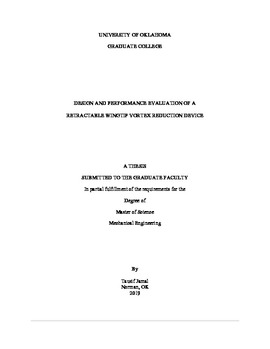| dc.contributor.advisor | Walters, D.Keith | |
| dc.contributor.author | Jamal, Tausif | |
| dc.date.accessioned | 2020-01-03T15:16:58Z | |
| dc.date.available | 2020-01-03T15:16:58Z | |
| dc.date.issued | 2019-12 | |
| dc.identifier.uri | https://hdl.handle.net/11244/323260 | |
| dc.description.abstract | As an airfoil achieves lift, the pressure differential at the wingtips trigger the roll up of fluid which results in swirling wakes. This wake is characterized by the presence of strong rotating cylindrical vortices that can persist for miles. Since large aircrafts can generate strong vortices, airports require a minimum separation between two aircrafts to ensure safe take-off and landing. Recently, there have been considerable efforts to address the effects of wingtip vortices such as the categorization of expected wake turbulence for commercial aircrafts to optimize the wait times during take-off and landing. However, apart from the implementation of winglets, there has been little effort to address the issue of wingtip vortices via minimal changes to airfoil design. The primary objective of this study is to evaluate the performance of a newly proposed retractable wingtip vortex reduction device for commercial aircrafts. The proposed design consists of longitudinal slits placed in the streamwise direction near the wingtip to reduce the pressure differential between the pressure and the suction sides. This passively bled air introduces turbulent fluctuations which interact and dissipate some of the wingtip vortex strength. Results from numerical simulations performed on a NACA 0012 airfoil and a flat plate suggest that the proposed design can mitigate the strength of wingtip vortices without significant changes to existing airfoil designs with some penalty in the form of added drag and a decrease in lift. However, these inefficiencies could potentially be offset by increased air traffic via a reduction in take-off and landing wait-times. It was concluded that the proposed design reduces wingtip vortex strength and further improvements in performance could be achieved by making design adjustments to the leading edge of the airfoil where vortex generation mechanism is initiated. | en_US |
| dc.language | en_US | en_US |
| dc.rights | Attribution-NonCommercial-NoDerivatives 4.0 International | * |
| dc.rights.uri | https://creativecommons.org/licenses/by-nc-nd/4.0/ | * |
| dc.subject | Physics, Fluid and Plasma. | en_US |
| dc.subject | Engineering, Aerospace. | en_US |
| dc.subject | Engineering, Mechanical. | en_US |
| dc.subject | Computational Fluid Dynamics | en_US |
| dc.subject | Wingtip Vortex | en_US |
| dc.subject | Airfoil | en_US |
| dc.title | Design and Performance Evaluation of a Retractable Wingtip Vortex Reduction Device | en_US |
| dc.contributor.committeeMember | Shabgard, Hamidreza | |
| dc.contributor.committeeMember | Vedula, Prakash | |
| dc.date.manuscript | 2019-12-04 | |
| dc.thesis.degree | Master of Science | en_US |
| ou.group | Gallogly College of Engineering::School of Aerospace and Mechanical Engineering | en_US |

